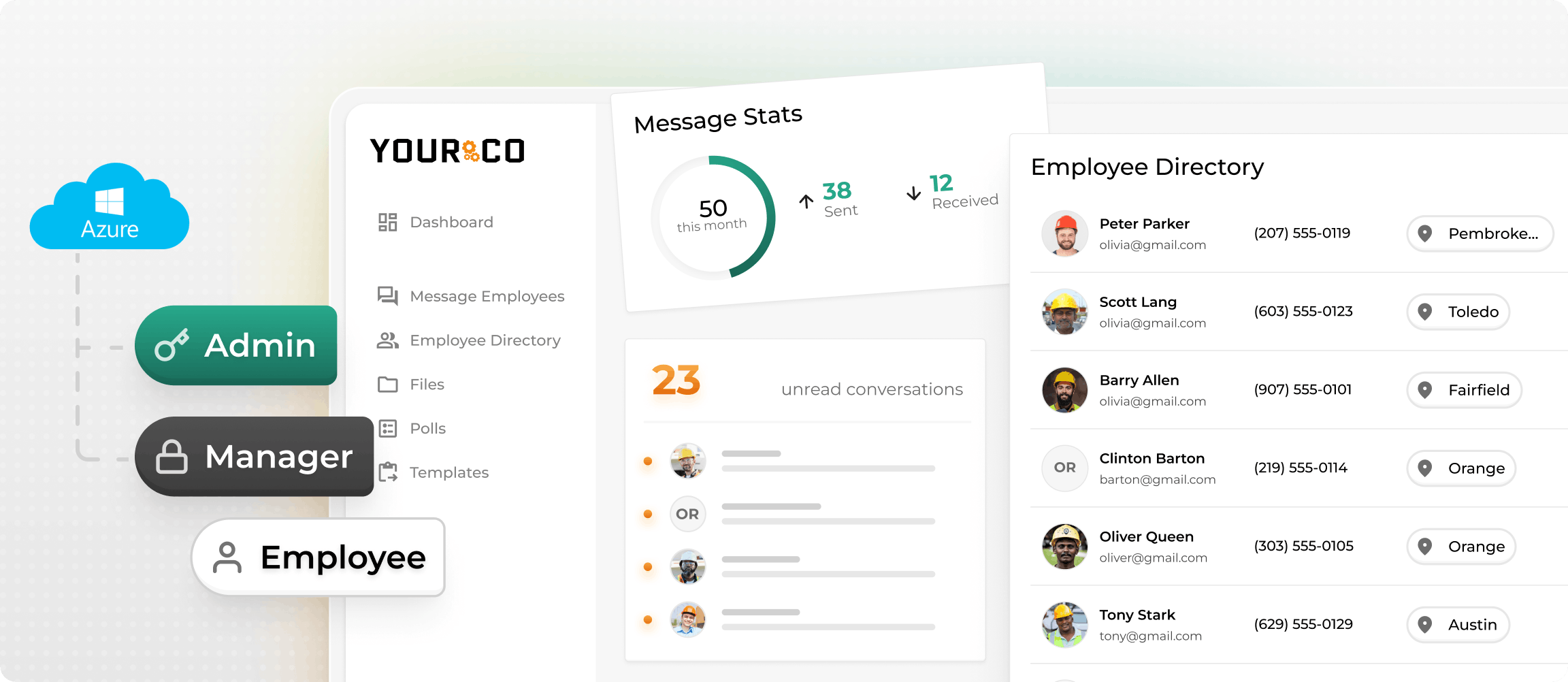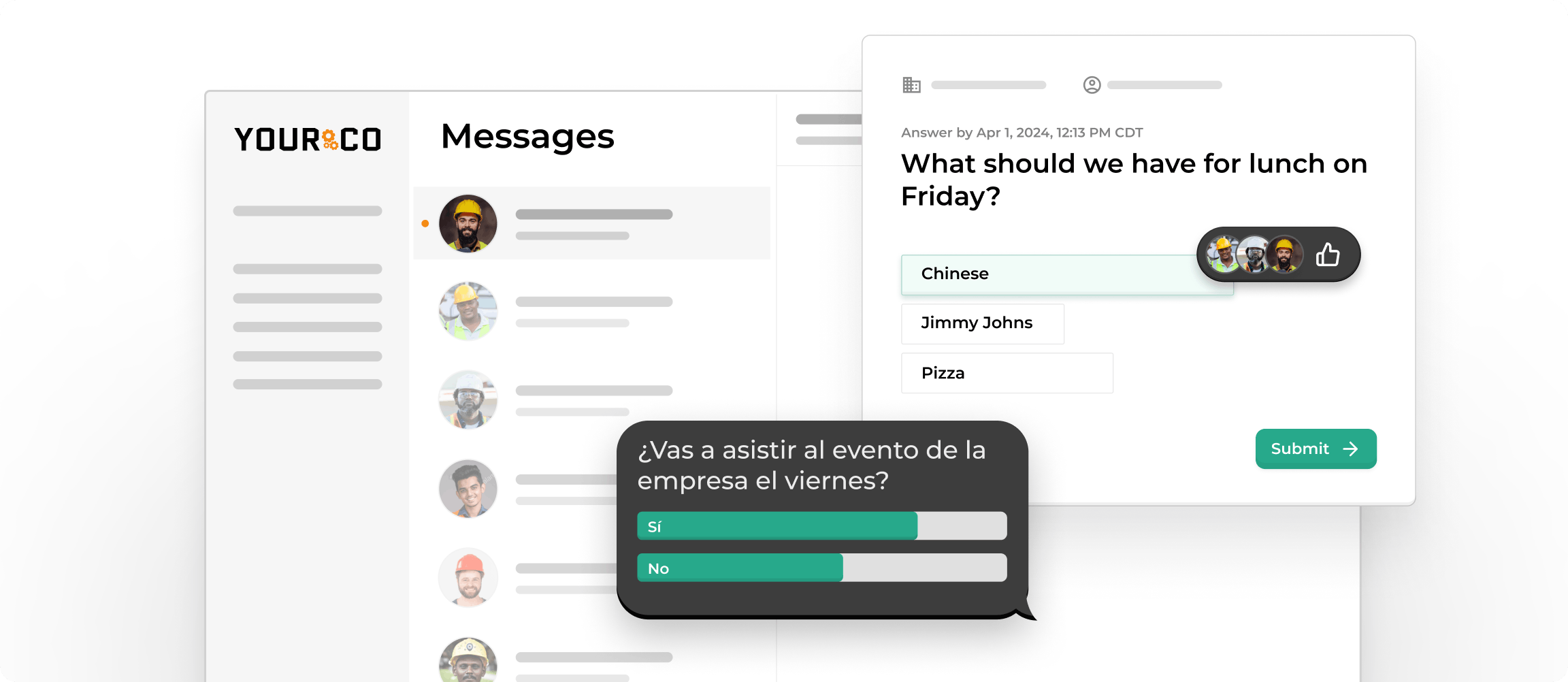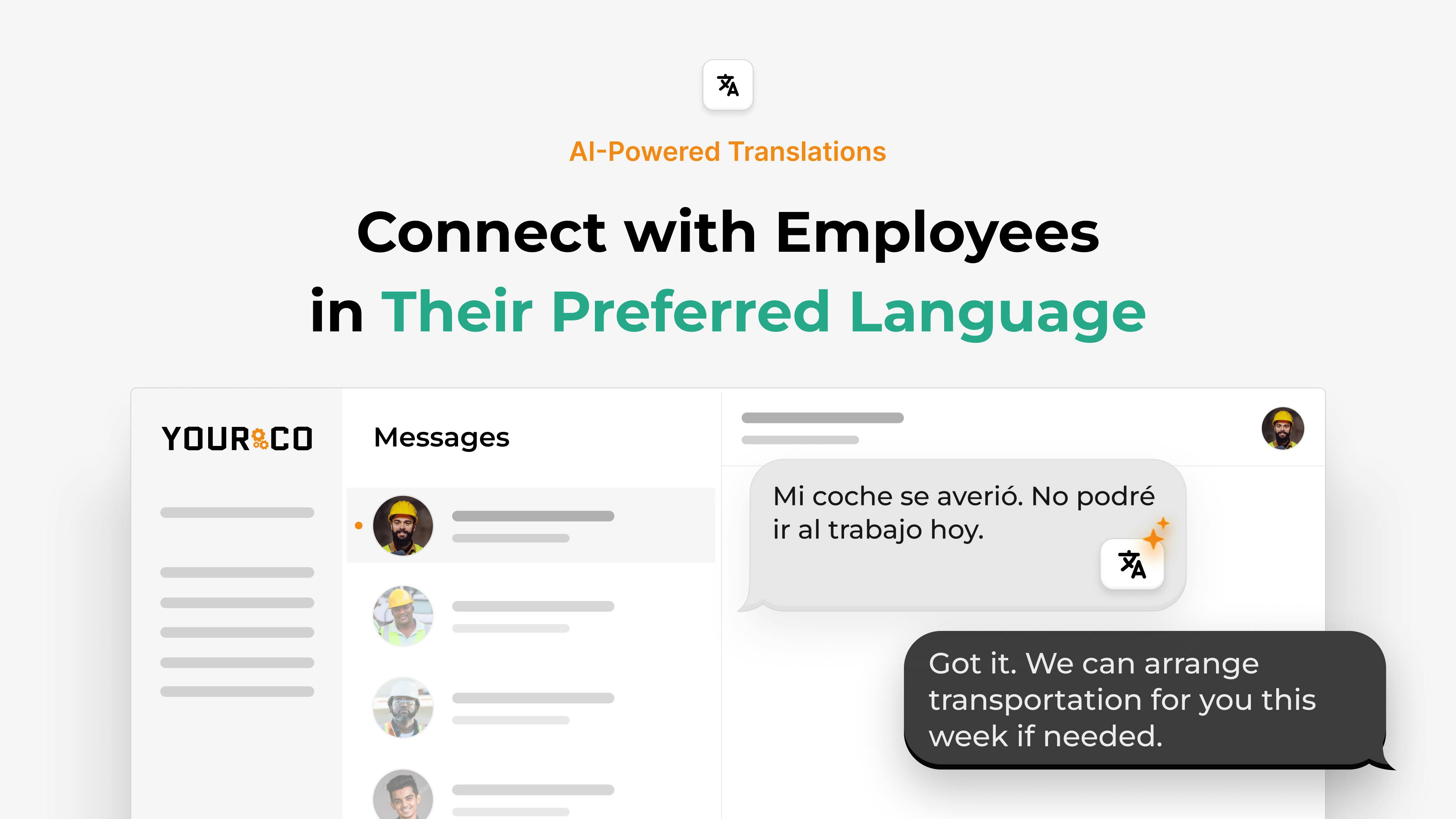How to Offer Scalable Benefits that Adjust to Shift Work and High-Turnover Part-Time Roles


If you're struggling to keep shift workers engaged, you're not alone. Non-desk workers and shift-based teams deal with unpredictable schedules, high turnover, and limited access to the same resources your desk-based colleagues enjoy. Your standard benefit packages probably don't fit their reality either. What works for your nine-to-five office workers won't necessarily help your night-shift machine operators, weekend retail cashiers, or part-time construction laborers deciding whether to stay after their first month.
To make benefits truly work for your shift and part-time teams, you need a system that's flexible, cost-effective, and responsive to changing needs. That means understanding what your workers value most, designing programs that scale with tenure and role, and delivering information in ways that reach every crew member, regardless of when they clock in.
This guide walks you through how to build a benefits program that adapts to shifting schedules, keeps your budget under control, and gives your workers real reasons to stick around.
Identify What Shift Workers Value Most
Unlike desk workers, shift teams need benefits that work with unpredictable schedules and unique challenges. Their preferences can vary across industries. In manufacturing, job monotony and automation concerns rank high. In construction, safety risks and job availability matter most. Night shift or weekend crews face different challenges than day teams.
Here's what matters most to shift workers:
- Flexible scheduling and time-off benefits address unpredictable schedules that fuel frustration. Giving workers control over their schedules boosts morale and keeps them around longer.
- On-demand pay or earned wage access meets immediate financial needs between traditional pay cycles. The option to access earned wages before payday helps when car repairs or medical bills hit unexpectedly.
- Childcare support or backup care becomes crucial for shift workers with families. Access to reliable childcare can mean the difference between staying with or leaving an employer.
- Health and wellness access during non-standard hours recognizes that shift work affects health. Flexible healthcare benefits and wellness programs become essential, not optional.
- Consistent communication and recognition helps reduce the disconnect felt by those outside traditional work hours.
To address these concerns properly, gather input directly from your workforce using quick surveys, exit interviews, and onboarding feedback. Ask specific questions like "Which benefits would make your work-life balance better?" or "What scheduling flexibilities would improve your job satisfaction?"
When benefits reflect these priorities, job satisfaction improves and workers stay longer. This sets the stage for smart benefit design.
Build a Modular Benefits Framework That Scales by Role and Tenure
A modular benefits framework breaks each benefit into separate pieces. You decide which pieces every employee receives, which unlock after 90 days, and which only experienced teammates earn. Since each piece stands alone, you can add, drop, or swap perks without rebuilding the whole program.
This approach works especially well for shift and part-time teams. Flexibility keeps costs down because you only fund what gets used, cutting waste from overlooked perks. When workers feel their specific needs are met, they're more likely to stay. Tailoring benefits to life stage, tenure, or role sends a clear message that every employee matters.
Structure Three Practical Tiers
- Core benefits start on day one, giving every worker safety-net essentials like earned-wage access, basic telemedicine, and mental-health hotlines. These meet urgent needs without big, long-term costs.
- Growth benefits unlock after 30, 60, or 90 days once attendance stabilizes. Add real value with low-cost dental, discounted transit passes, or paid training vouchers. Tying rewards to concrete milestones encourages workers to stick around for the next step.
- Premium benefits come at the one-year mark or for skilled roles. Save costly perks like tuition reimbursement, enhanced PTO banks, or family health coverage for proven performers. This balances generosity with loyalty.
Build Your Framework Step by Step
Start by identifying universal must-haves through polling your frontline team, new hires, and recent exits. Usually this means real-time pay and around-the-clock telehealth.
Next, map tenure milestones using your turnover data to pinpoint danger zones. If many employees quit between 60 and 90 days, place an appealing benefit like shift-differential bonuses right before that cliff.
Create a simple catalog covering health, financial, family, education, and wellness options. Tag each with eligibility rules and cost per employee. Consider offering points or credits instead of forcing a package — give workers credits they can spend on any benefit in their tier. A night-shift parent might choose backup childcare while a weekend-only student might pick gym access and tuition aid.
Review usage every quarter by tracking what gets used and connecting it to turnover. If few people use a benefit, swap it out. Clear communication about available benefits can cut quit rates significantly, so even basic outreach lifts your return on investment.
Calculate Cost and ROI
Modular contracts let you pay only for what gets consumed, dropping underperforming perks mid-cycle without penalties. This approach typically pays for itself through lower replacement costs. Shaving just one percentage point off turnover in a 200-person facility often covers a year of core benefits.
You also get flexible budgeting. As peak season approaches, you can scale overtime meals or ride-share credits for temporary workers, then wind them down afterward. No long-term commitments, no waste.
Treating benefits like interchangeable parts keeps you nimble, controls spending, and gives every shift worker a clear reason to stay past the first paycheck.
Make Benefits Accessible Across All Shifts and Devices
Getting benefit details in front of every employee starts with acknowledging a basic truth: shift workers live on different timetables and often lack steady access to company email or HR portals. Irregular hours, shared equipment, and varied languages mean a single-channel approach won't work.
A multi-channel approach solves that gap by mixing delivery methods so each worker sees information when and where it suits them.
- Text messages work particularly well for shift workers — sending concise benefit summaries, enrollment reminders, and deadline alerts directly to any phone, including basic models.
- Short emails employees can read off-hours and mobile-friendly websites that load without complex logins provide detailed information.
- Physical methods cover flyers on noticeboards, paycheck stuffers, wallet-sized cards with hotline numbers, and QR codes posted by timeclocks.
- Face-to-face communication happens through quick reminders during shift handovers, five-minute walk-throughs in pre-shift huddles, and supervisors who can answer questions on the spot.
Once the channels are in place, focus on easy access. Design everything mobile-first so a worker can enroll for dental coverage on a coffee break without hunting for a computer. Keep the process available outside standard HR hours — night crews should never wait until morning for help. Add automatic translations or pictograms so no one relies on coworkers to interpret critical details about health coverage or retirement contributions.
Sustaining awareness takes a few repeatable habits. Time text reminders to arrive at the start of each crew's shift, place QR codes in high-traffic zones linking directly to short explainer videos or one-page FAQs, and nominate "benefit champions" on every team — folks who enjoy helping peers and can flag patterns to HR before confusion snowballs.
Track reach and response by noting how many workers saw the text, scan QR codes, or finish enrollment forms. Pair that data with quick pulse surveys to learn which messages land and which feel like noise. Regularly ask about preferences and adjust the channel mix instead of blasting louder.
Treat the plan like any other piece of equipment on the floor: inspect it, service it, and upgrade it. A disciplined loop of feedback, small tweaks, and clear follow-ups keeps benefits accessible, so every employee, on every shift, gets the support you're already paying to provide.
Design Benefits for Turnover Without Rewarding Job-Hopping
Offer too much too quickly and you attract serial job-hoppers. Offer too little too late and you lose good people before they learn everyone's names. The right approach gives shift and part-time workers real help on day one while raising the value the longer they stay.
Choose Core Benefits That Build Trust for New Hires
New hires often leave because basic needs go unmet. Meeting those needs up front keeps anxiety low and gives you time to build loyalty through day-one benefits that focus on stability, not long-term cost:
- Mental health support that workers can reach after hours
- A simple healthcare-navigation hotline so workers know where to get care at 2 a.m.
- Emergency wage advances or relief funds for sudden car repairs, rent, or medical bills
These quick wins show you understand their challenges without locking you into expensive promises before the employee proves they're staying.
Mix in Growth Benefits to Keep Employees Engaged
From there, add incentives at clear milestones — 30, 60, and 90 days work well for high-turnover roles. Offer a paid personal day at 30 days, a shift differential bump at 60, and a skills-training stipend or certification voucher at 90. Workers begin to see a future with your company, while you protect the budget if they leave early.
Past the 90-day mark, switch to tenure-based perks:
- Extra paid time off each year
- Larger earned-wage-access limits
- Quarterly attendance bonuses
These benefits tackle the top reasons people leave (burnout and stagnant wages) without feeling like entitlements to newcomers.
Incentivize Key Behaviors and Reward Consistent Performance
Recognition and referral programs add another layer. Thank perfect-attendance streaks on the break-room board, send small gift-card codes after a safety win, and pay referral bonuses only after the new hire's 90-day milestone. This structure rewards staying power and turns loyal employees into recruiters.
Even graceful exits matter. Offboarding guides, alumni updates about open roles, and a short window of healthcare transition support leave the door open for boomerang hires. Former employees who return often get up to speed faster and stay longer.
To prove the investment works, track cost per employee for each benefit layer, turnover rate at 30, 60, 90 days and one year, plus replacement cost saved when turnover drops. When the savings from fewer departures outweigh benefit spend, the program pays for itself, and your frontline team gains a clear reason to stick around.
Partner With Vendors Who Understand Shift Work Realities

The right vendor makes benefits simple for every worker, no matter when they clock in. Start with the basics during your vetting process. Look for platforms that integrate with your current systems in days, not months. Strong vendors already have connectors for major HRIS tools and can automate eligibility as hours change. Mobile access matters just as much since shift workers reach for their phones, not company laptops. Benefits need to work through text or load in two taps. Multi-language support keeps information clear for every crew member.
Ask pointed questions before you sign:
- How fast can you add or remove 100 employees during peak season?
- Does the platform work over text messages, not just apps?
- Can we set different waiting periods by job code?
- What languages do you support out of the box?
- How do you protect personal data, and who owns that data if we switch vendors?
Shift teams need specific benefit types. Earned wage access providers give workers instant cash between paydays, reducing stress and cutting loan reliance. 24/7 telemedicine lets a night-shift welder talk to a doctor at 3 a.m. Financial wellness platforms teach hourly staff how to budget irregular wages, while childcare assistance covers the early-morning drop-off gap. Vendors with proven results in these areas understand the unique challenges frontline workers face.
When contracts come up, keep flexibility front and center. Negotiate month-to-month seat counts, opt-out clauses for underused modules, and price tiers tied to participation. Insist on clear service-level targets for response times and include a data-return clause so you aren't locked in.
Combine sharp questions, proof of frontline success, and contracts that move with your staffing reality. This approach secures partners who help retain workers instead of creating barriers.
Keep Your Best Workers With Smart Benefits Communication
A successful benefits program centers on one simple principle: deliver the right benefit when workers need it most, and make sure they can find it. This means flexible options that adapt to different schedules and experience levels, paired with clear communication that reaches everyone.
Clear communication makes or breaks any benefits program. Text messages reach every line operator, loader, and field technician with 98% message read rates. Since texts work on any phone without downloads or logins, workers stay informed whether they're on a break in the loading dock or between shifts. Built-in language support eliminates confusion, while quick polls help you identify which benefits resonate most before renewal time.
Yourco's SMS platform ensures every employee knows about available benefits, enrollment deadlines, and program updates through simple text messages. With automatic translations in over 135 languages and dialects, and integration with existing HR systems, your team can focus on the benefits that matter most while Yourco handles the communication that makes them stick.
Try Yourco for free today or schedule a demo and see the difference the right workplace communication solution can make in your company.
Frequently Asked Questions
How Do You Communicate Benefits to Employees Who Don't Have Smartphones?
Text messaging works on any cell phone, including basic flip phones. You can also use physical materials like paycheck stuffers, break room posters, and QR codes that employees can scan during breaks.
What's the Best Way to Measure if a Benefits Program Is Working?
Track four key metrics monthly: participation rates by shift, benefit usage by employee tenure, the connection between benefit usage and voluntary turnover, and cost per employee versus replacement hiring costs.
How Can We Offer Competitive Benefits Without Breaking the Budget?
Use a modular approach with three tiers: core benefits for everyone, growth benefits after 30-90 days, and premium benefits for long-term employees. This way you only pay for benefits that get used while still providing immediate value.
Should We Offer the Same Benefits to Part-Time and Full-Time Shift Workers?
Consider a points or credits system where employees can choose benefits that match their needs. A part-time student might value tuition assistance, while a full-time parent might prefer childcare support or earned wage access.
How Often Should We Review and Update Our Benefits Offerings?
Review usage data quarterly and gather employee feedback through quick surveys. Benefits that underperform for two consecutive quarters should be evaluated for replacement or modification.




